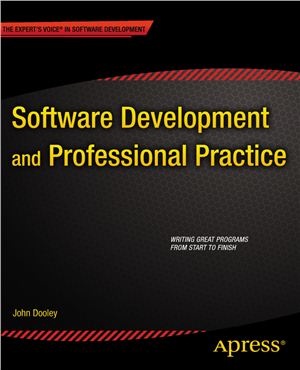Apress, 2011. - 242 p.
Software Development and Professional Practice reveals how to design and code great software. What factors do you take into account? What makes a good design? What methods and processes are out there for designing software? Is designing small programs different than designing large ones? How can you tell a good design from a bad one? You'll lea the principles of good software design, and how to tu those principles back into great code.
Software Development and Professional Practice is also about code construction—how to write great programs and make them work. What, you say? You've already written eight gazillion programs! Of course I know how to write code! Well, in this book you'll re-examine what you already do, and you'll investigate ways to improve. Using the Java language, you'll look deeply into coding standards, debugging, unit testing, modularity, and other characteristics of good programs. You'll also talk about reading code. How do you read code? What makes a program readable? Can good, readable code replace documentation? How much documentation do you really need?
This book introduces you to software engineering—the application of engineering principles to the development of software. What are these engineering principles? First, all engineering efforts follow a defined process. So, you'll be spending a bit of time talking about how you run a software development project and the different phases of a project. Secondly, all engineering work has a basis in the application of science and mathematics to real-world problems. And so does software development! You'll therefore take the time to examine how to design and implement programs that solve specific problems.
Finally, this book is also about human-computer interaction and user interface design issues. A poor user interface can ruin any desire to actually use a program; in this book, you'll figure out why and how to avoid those errors.
Software Development and Professional Practice covers many of the topics described for the ACM Computing Curricula 2001 course C292c Software Development and Professional Practice. It is designed to be both a textbook and a manual for the working professional.
What you’ll lea
- How to design and code great software
- What methods and processes are available to help you design great software
- How to apply software engineering principles to your daily coding practice
- How to tell a good design from a bad one?
- Understand the characteristics of good programs
- How to construct professional standard code that you can be proud to show
- Understand all about coding standards, and apply them to real Java coding
- Explore debugging, unit testing and modularity
- All about object-oriented programming (OOP) design principles and great coding
- How to apply the principles you've leaed to specific and real-world coding problems
- A companion to the ACM Computing Curricular 2001 source C202c
Software Development and Professional Practice reveals how to design and code great software. What factors do you take into account? What makes a good design? What methods and processes are out there for designing software? Is designing small programs different than designing large ones? How can you tell a good design from a bad one? You'll lea the principles of good software design, and how to tu those principles back into great code.
Software Development and Professional Practice is also about code construction—how to write great programs and make them work. What, you say? You've already written eight gazillion programs! Of course I know how to write code! Well, in this book you'll re-examine what you already do, and you'll investigate ways to improve. Using the Java language, you'll look deeply into coding standards, debugging, unit testing, modularity, and other characteristics of good programs. You'll also talk about reading code. How do you read code? What makes a program readable? Can good, readable code replace documentation? How much documentation do you really need?
This book introduces you to software engineering—the application of engineering principles to the development of software. What are these engineering principles? First, all engineering efforts follow a defined process. So, you'll be spending a bit of time talking about how you run a software development project and the different phases of a project. Secondly, all engineering work has a basis in the application of science and mathematics to real-world problems. And so does software development! You'll therefore take the time to examine how to design and implement programs that solve specific problems.
Finally, this book is also about human-computer interaction and user interface design issues. A poor user interface can ruin any desire to actually use a program; in this book, you'll figure out why and how to avoid those errors.
Software Development and Professional Practice covers many of the topics described for the ACM Computing Curricula 2001 course C292c Software Development and Professional Practice. It is designed to be both a textbook and a manual for the working professional.
What you’ll lea
- How to design and code great software
- What methods and processes are available to help you design great software
- How to apply software engineering principles to your daily coding practice
- How to tell a good design from a bad one?
- Understand the characteristics of good programs
- How to construct professional standard code that you can be proud to show
- Understand all about coding standards, and apply them to real Java coding
- Explore debugging, unit testing and modularity
- All about object-oriented programming (OOP) design principles and great coding
- How to apply the principles you've leaed to specific and real-world coding problems
- A companion to the ACM Computing Curricular 2001 source C202c

